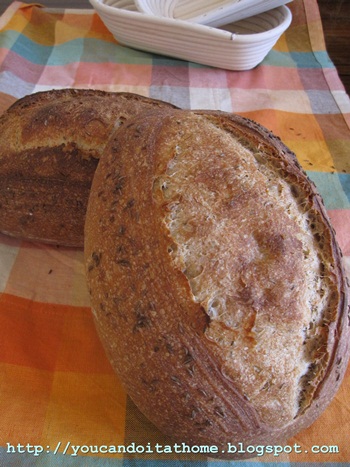I have just started to move to Sourdough Rye bread section of Jeffrey Hamelman's Bread book after baking from the book for several months. I like the flavour that rye adds to the bread, the tang and acidic taste.
All recipes from rye bread section of the book require instant yeast in addition to sourdough starter, which I was so curious that I put a post in TFL asking what are the reasons behind it and if rye dough can be retarded (Hamelman didn't' give an option to retard any of rye dough in his book). I usually retard the dough in the evening and bake in the morning as it suits my schedule better and long fermentation provides better flavour.
Thanks to Mini, Andy (ananda) and Sam Fromartz who gave wonderful advices to the post. I'm new to working with rye flour, those insightful advices were really helpful for me getting on the right rye track.
Light rye bread with 15% rye flour sounds like a good choice to start my rye-learning-path. The bread also contains 1.6% of caraway seeds, which lift the sour flavour of the bread even more.
I followed Hamelman's recipe roughly. I did retard the dough overnight so I omitted the yeast, increase percentage of rye sour in the starter built and increase fermentation time to compensate this.
I have to admit, even though I was assured by Mini that bread with 15% rye can be easily retarded, after I retarded the dough, I was in bed thinking and wondering if the bread would be alright, what if it was over-fermented and turned gummy texture. First thing when I got up was to check on the doughs. It was a huge relief to see that the dough was alright, phew.
The bread turned out nicely with nice and open crumb and I am happy to report that this type of rye bread can be retarded.
More details and recipe are here.


I also made Portuguese Custard Tart last weekend, with home-made puff pastry. I usually made rough puff pastry instead of the classic one as it is much quicker and less complicated, yet the end result is relatively similar, the same buttery and flaky goodness with 50% less work.
The pastry post is here.

The puff pastry was also used for making chorizo pissaladière (the French take on Italian pizza).
 Rough puff pastry gives a decent layers with much less work
Rough puff pastry gives a decent layers with much less work
The pastry post is here.
Sue
http://youcandoitathome.blogspot.com

